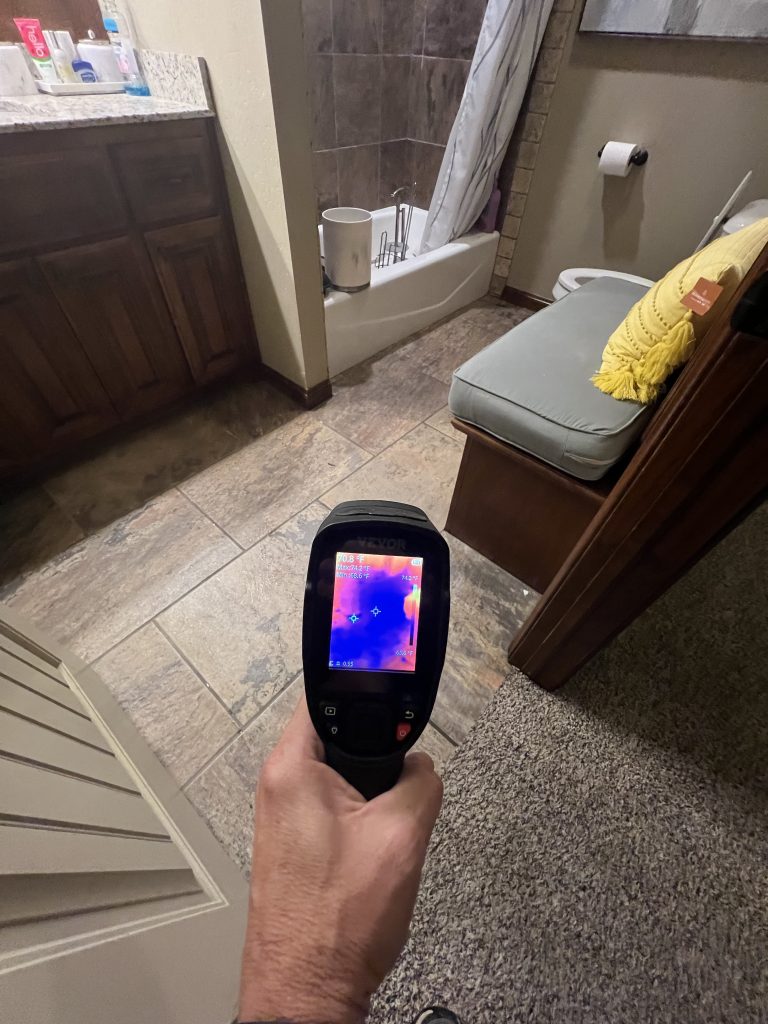
We don’t guess. We test. We don’t delay. We extract. Water damage doesn’t wait — neither should you.
Don’t Panic, Take Control — The First 10 Minutes Count
The moment you discover water damage in your home or business, the clock starts ticking. Every second that water sits, the destruction compounds. Mold begins to germinate within 24-72 hours, drywall soaks and crumbles, wood swells, and carpets start to stink. Your first 10 minutes matter more than you think.
Here’s your first mission:
- Shut off the water.
- Kill power if electrical systems are wet.
- Take photos before moving anything.
“Every second water sits, the damage compounds. Act now.” — Jeremy Reets
Step 1 – Stop the Source (and the Panic)
If a pipe burst or appliance overflowed, shut off your main valve. If you can’t find it, call someone who can ASAP. Do NOT wait. Get help en route while you stabilize the scene.
“If it’s still leaking and you’re walking in it, that’s active water. That’s an emergency.”
Step 2 – Document Everything (Before Cleanup)
Insurance companies don’t pay for what they can’t see. Start snapping photos and videos of every affected room. Include:
- Wet walls and ceilings
- Damaged belongings
- Water lines on baseboards or drywall
“You can’t show the insurance what’s missing if you didn’t document what was there.”
Step 3 – Start Basic Extraction (Only If Safe)
If the water is safe (not black water or from sewage), and only a small area is wet:
- Use a wet/dry vac
- Elevate furniture with foil or plastic
- Remove soaked rugs to prevent dye transfer
But DON’T tear into drywall, pull up carpet, or bring out a box fan. Surface drying is not enough.
Step 4 – Call a IICRC Trained Water Damage Pro
This is where we come in.
We bring in:
- Moisture meters
- Thermal imaging
- HEPA air scrubbers
- Industrial drying equipment
“I’ve seen homeowners rip out drywall too early, or not at all — both are wrong.”
Don’t guess. Don’t overdo it. Don’t under-do it. Call a highly-trained professional.
Step 5 – Do NOT Wait on Insurance to Act
We get it. You want to call your agent. But if you wait for approval before mitigating the damage, insurance might deny your claim.
“Waiting for an adjuster to give permission is how mold starts.”
They expect you to act now, then file a claim.
The 72-Hour Rule: Mold Moves Fast
- Mold spores begin to germinate within 24 hours in warm, wet conditions.
- By 72 hours, colonies are visible.
- Insurance may exclude mold remediation if you delayed mitigation.
Moisture hides behind walls, under floors, and inside cabinets. Surface drying is a lie. Professionals dry through and through with monitored results.
FAQ: Common Questions We Hear from Homeowners
Q: Should I call my insurance company before or after cleanup?
A: Call a certified restoration company first. Insurance expects you to act fast and prevent further damage. Delaying can cost you.
Q: Is water damage covered by homeowners insurance?
A: Usually yes — for sudden events (burst pipe, AC overflow). Not covered if it’s long-term or maintenance-related. Document everything.
Q: How soon does mold grow after water damage?
A: Mold can start growing in as little as 24 hours in warm, moist environments. That’s why professional drying ASAP is critical.
Q: Can I dry it myself with fans?
A: Surface drying with fans won’t reach hidden water. Professionals use meters, injectidry systems, and dehumidifiers to dry through materials, not just the surface.
Final Word
If you’re reading this while water is on your floor, stop and call us now. We’re local, IICRC-trained, and on-call 24/7.
Water damage waits for no one. But we don’t wait either.
Call Advanced Vacuum & Extraction — OKC’s Emergency Water Removal Team
